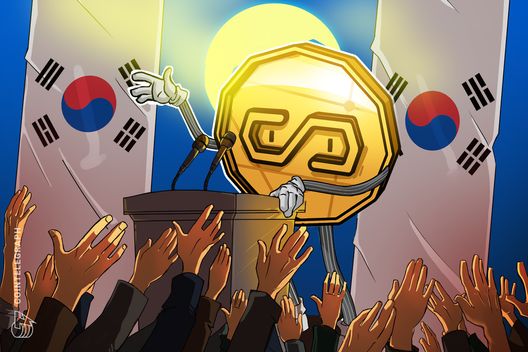
South Korea's Stablecoin Strategy: A Flawed 'Bank-First' Approach Under Scrutiny

As South Korea continues to navigate the evolving landscape of digital finance, its approach to stablecoin regulation is drawing significant attention – and criticism. Dr. Sangmin Seo, the distinguished chair of the Kaia DLT Foundation, has voiced a critical perspective, arguing that the Bank of Korea's (BoK) apparent 'bank-first' strategy for stablecoin issuance lacks fundamental logic. His core message is clear: for a vibrant and innovative digital economy to flourish, the BoK must establish unambiguous rules that empower both traditional financial institutions and innovative non-bank entities to issue stablecoins.
The 'Bank-First' Conundrum: Stifling Innovation?
The concept of a 'bank-first' approach in stablecoin regulation typically implies that the primary, if not exclusive, privilege of issuing these crucial digital tokens would be reserved for established financial institutions like commercial banks. While this strategy might seem appealing from a traditional regulatory standpoint – leveraging existing oversight, capital requirements, and consumer trust – Dr. Seo contends it presents a significant hurdle for South Korea's burgeoning digital economy. By limiting stablecoin issuance to banks, the country risks creating a monopolistic environment, potentially stifling the very innovation and competition that distributed ledger technology (DLT) and Web3 aim to foster.
This restrictive approach could inadvertently curb the development of novel use cases for stablecoins, which often emerge from agile, tech-focused non-bank entities. These innovators are frequently at the forefront of exploring stablecoin applications beyond traditional payment systems, such as within decentralized finance (DeFi), gaming, metaverse platforms, and micropayments. A bank-centric model might not only delay South Korea's adoption of cutting-edge digital financial services but also place it at a disadvantage compared to other nations embracing more inclusive regulatory frameworks.
Why Inclusivity Matters: A Call for Open Competition
Dr. Seo's advocacy for allowing non-bank entities into the stablecoin issuance arena is rooted in the belief that an inclusive ecosystem drives progress. Opening the market to diverse players fosters healthy competition, which can lead to lower transaction costs, improved efficiency, and a wider array of stablecoin products tailored to various market needs. Non-bank innovators, often unburdened by legacy systems, are typically faster at adapting to new technologies and identifying niche demands, thereby accelerating the overall advancement of the DLT space.
Furthermore, an open market encourages greater investment in digital asset infrastructure and talent, positioning South Korea as a leader in the global digital economy. Allowing non-banks to participate alongside banks would create a dynamic environment where the best solutions, whether from a seasoned financial giant or an agile tech startup, can rise to the top. This approach isn't about undermining banks but about creating a level playing field where innovation isn't arbitrarily constrained by institutional type.
Crafting a Robust, Issuer-Agnostic Regulatory Framework
It's crucial to understand that Dr. Seo is not advocating for a deregulated free-for-all. Instead, he stresses the urgent need for the Bank of Korea to establish clear, comprehensive, and issuer-agnostic rules for stablecoin regulation. Such a framework should prioritize consumer protection, market stability, and transparency, regardless of whether the issuer is a bank or a non-bank entity. Key components of such a robust framework would include:
- Clear Capital and Reserve Requirements: Mandating sufficient reserves and capital to ensure the stability and redeemability of stablecoins.
- Rigorous Auditing and Transparency: Regular, independent audits to verify reserves and clear disclosure of operational practices.
- Risk Management Protocols: Guidelines for managing technological, operational, and financial risks associated with stablecoin issuance.
- Consumer Safeguards: Mechanisms to protect users from fraud, market manipulation, and operational failures.
- Interoperability Standards: Encouraging standards that allow different stablecoins and platforms to interact seamlessly.
By focusing on the 'what' – the nature of the stablecoin and its risks – rather than the 'who' – the type of entity issuing it – the Bank of Korea can create a fair and predictable environment that encourages responsible innovation from all quarters.
Global Stablecoin Trends and South Korea's Position
Across the globe, major economies are moving towards comprehensive stablecoin regulation that often includes provisions for non-bank issuers, albeit with stringent oversight. The European Union's MiCA (Markets in Crypto-Assets) regulation, for instance, provides a clear framework for various types of crypto-asset service providers, including stablecoin issuers, irrespective of whether they are banks. Similarly, the United Kingdom and the United States are exploring regulatory paths that acknowledge the role of non-bank entities in the digital asset space.
South Korea, known for its technological prowess and digital-savvy population, has an opportunity to position itself as a leader in the digital finance arena. Adopting a narrow, bank-exclusive stablecoin policy risks isolating the nation from global innovation trends and hindering its competitiveness in the broader Web3 ecosystem. The Kaia DLT Foundation, under Dr. Seo's leadership, aims to contribute to this discourse by advocating for policies that are both forward-thinking and pragmatic.
Conclusion
Dr. Sangmin Seo's critique serves as a timely reminder for the Bank of Korea: the future of finance is increasingly digital, and stablecoins are a foundational component of this shift. While prudence is essential, an overly restrictive 'bank-first' approach could inadvertently stifle innovation, limit competition, and ultimately disadvantage South Korea in the global race for digital supremacy. By embracing clear, inclusive, and issuer-agnostic regulations, the BoK can unlock the full potential of stablecoins, foster a thriving DLT ecosystem, and solidify South Korea's position as a true pioneer in the digital economy.
Keywords: Crypto
